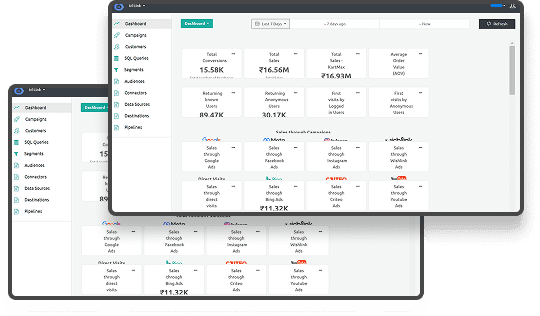Tips to Optimize Your Marketing ROI
Struggling to see a return on your marketing efforts despite spending big? You’re not alone. Many businesses pour money into campaigns only to see minimal results.
Whether you're working with a tight budget or have a little more flexibility, digital marketers continually seek ways to maximize every advertising dollar, enhance the effectiveness of each campaign, and optimize ROI. In today’s unpredictable economy, it’s essential to know which marketing efforts are yielding results and which ones are simply wasting money.
In this blog, we will break down simple and practical tips to help you improve your marketing return on investment (ROI).
Let’s start by discussing why optimizing your marketing ROI is so important.
Why Marketing ROI Optimization Matters
Optimizing your marketing ROI means you ensure every dollar spent on marketing brings in the highest possible return. When you focus on marketing ROI optimization, you can:
- Increase Efficiency: By understanding which campaigns work best, you can focus your budget where it matters most.
- Boost Profitability: A higher ROI means more revenue generated for every dollar invested.
- Enhance Decision-Making: Data-driven insights allow you to make smarter marketing decisions, reducing waste and increasing effectiveness.
- Gain Competitive Advantage: Businesses that optimize their marketing spend are better positioned to outpace competitors.
This focus on ROI is critical because the digital world is flooded with marketing channels and data. For instance, tracking the performance of your campaigns using UTM Parameters and Best Practices for Tracking Campaigns can give you clear insights into which efforts are yielding the best results.
Now that we understand why it matters, let’s explore how to set up your marketing strategy for success.
Establishing Clear Goals and Metrics
Before we look into campaign execution, you need to know what you’re aiming for. Setting clear, measurable goals is the first step in marketing ROI optimization. These goals could range from increasing website traffic and generating leads to boosting sales or improving brand awareness.
1. Define Your Objectives:
Identify the key performance indicators (KPIs) that matter most for your business. These could include conversion rates, customer acquisition cost (CAC), lifetime value (LTV), Average Order Value (AOV) and return on ad spend (ROAS). Calculating ROAS can help you understand the financial returns of your campaigns.
2. Set Realistic Targets:
Use historical data and industry benchmarks to set achievable targets. Clear targets guide your efforts and make it easier to measure success over time.
3. Monitor and Adjust:
Continuously track your KPIs and adjust your strategies based on performance. For instance, if you notice that one channel is performing better than others, you might want to allocate more budget there.
These initial steps lay a strong foundation for marketing ROI optimization by ensuring that you have a clear direction and measurable outcomes to aim for. For additional guidance, consider insights from Understanding Multi-Touch vs. Last-Touch Attribution, which explains how different attribution models can influence your strategy.
With your goals set, let’s consider fine-tuning your marketing channels.
Optimize Your Marketing Channels
Your marketing channels are the pathways that deliver your message to your audience. Optimizing these channels is a key component of marketing ROI optimization. Here’s how to do it:
1. Analyze Channel Performance:
Evaluate the performance of each marketing channel, including paid search, social media, email, and content marketing. This analysis lets you see which channels deliver the best ROI and which ones need improvement.
2. Focus on High-Performing Channels:
Allocate more resources to the channels that generate the highest returns. For instance, if your paid search campaigns yield better conversions, consider increasing the budget for these campaigns while reducing spend on underperforming channels.
3. Experiment with New Channels:
Sometimes, exploring new channels can reveal untapped potential. Testing emerging platforms or different ad formats can lead to unexpected wins. Insights on innovative approaches can be found in What is Programmatic Advertising and How Does It Work?.
4. Leverage Data for Personalization:
Use first-party data to create personalized marketing messages. For example, Crafting Unique Experiences with First-Party Data explains how personalized content can significantly improve engagement and conversion rates.
Focusing on channel performance ensures that your marketing efforts are aligned with where your audience is most active and engaged. By optimizing each channel, you not only maximize ROI but also create a more cohesive marketing strategy.
After refining your channels, the next step is to focus on your messaging and creative content.
Enhance Your Creative Messaging
Effective messaging and compelling creative content are vital to your marketing ROI. Your message must resonate with your target audience, prompting them to take action. Here’s how to optimize your messaging:
1. Know Your Audience:
Understand the needs, preferences, and pain points of your target audience. This insight allows you to craft messages that speak directly to them. Research and segmentation strategies are crucial, Behavioral Segmentation provides actionable tips for audience segmentation.
2. Craft Clear and Concise Messages:
Your messaging should be straightforward and focused on the benefits to the customer. Highlight how your product or service can solve their problems or improve their lives.
3. Use Strong Calls to Action (CTAs):
Effective CTAs guide your audience toward the next step, whether it’s making a purchase, signing up for a newsletter, or requesting more information. For inspiration on effective CTAs, consider reading Improving Meta Event Match Quality with Conversions API Tips.
4. Test Different Variations:
A/B testing your creative assets can help determine which messages and designs perform best. Experiment with different headlines, images, and formats to see what resonates most with your audience.
You can boost engagement and conversion rates by continuously refining your creative messaging, leading to better overall marketing ROI.
With your messaging optimized, let’s move on to advanced tracking and analytics.
Implement Advanced Tracking and Analytics
To truly master marketing ROI optimization, you need to measure every aspect of your campaigns. Advanced tracking and analytics provide the insights needed to refine your strategies and improve results. Here’s what to focus on:
1. Accurate Data Collection:
- Leverage Ingest Labs’ server-side tagging to gather precise, reliable data directly from your digital assets.
- This method ensures data accuracy while reducing reliance on client-side tracking methods.
2. Real-Time Data Streaming:
- Monitor user behavior and campaign performance as it happens.
- Use real-time analytics to quickly adjust campaigns and capitalize on emerging trends.
3. Seamless Integration:
- Integrates with over 100+ marketing tools, allowing for a unified view of your data.
- Centralizes data management, making it easier to analyze the complete customer journey.
4. Privacy-Friendly Approach:
- Ingest Labs collects data in a way that complies with privacy regulations.
- Ensures that tracking does not compromise user privacy or data security.
Advanced analytics not only help you understand your current performance but also enable you to predict future trends and adjust your campaigns proactively.
Now that you’ve set up advanced tracking, let’s focus on optimizing your budget allocation.
Optimize Budget Allocation
Efficient budget allocation is a cornerstone of marketing ROI optimization. By directing your marketing dollars toward the most effective channels and campaigns, you can maximize returns. Here are some tips for optimizing your budget:
1. Analyze Past Campaign Performance:
Use historical data to determine which campaigns have yielded the best results. Understanding past performance can help you allocate your budget more effectively in the future.
2. Test and Scale:
Start with smaller budgets for new campaigns and scale up as you see positive results. This iterative approach minimizes risk and ensures that you invest more in what works. Understanding Basics of Paid Media Campaigns with Examples offers valuable guidance on scaling campaigns.
3. Invest in High-ROI Channels:
Focus your spending on channels that deliver the highest ROI. Whether it’s social media advertising, email marketing, or content marketing, prioritize your budget where you see the most impact. Insights from Understanding and Optimizing Conversion Funnels in Digital Marketing can help you determine the best channels for your business.
4. Monitor and Adjust in Real Time:
Use real-time analytics to monitor your budget allocation and campaign performance continuously. Adjust your spending as needed to ensure optimal ROI.
5. Leverage Automation Tools:
Marketing automation tools can help you manage your budget more efficiently by automatically shifting funds between campaigns based on performance. Automation not only saves time but also ensures that your spending is aligned with your ROI goals.
Effective budget management enables you to make the most of your marketing spend and is a key driver for sustained ROI optimization.
After ensuring your budget is well-managed, it’s time to focus on refining your customer journey.
Refine the Customer Journey
The customer journey plays a significant role in your overall marketing ROI. A well-optimized journey can turn prospects into loyal customers. Here’s how to refine your customer journey for better results:
1. Map Out the Journey:
Understand each touchpoint your customers experience, from awareness to conversion and beyond. This helps you identify areas where improvements can be made. For an in-depth look at customer journey mapping, check out Track the Customer Journey Across Multiple Channels with Ingest Labs.
2. Personalize Interactions:
Use data to personalize each step of the customer journey. Personalized experiences have been shown to significantly improve engagement and conversion rates.
3. Streamline the Conversion Funnel:
Identify bottlenecks in your conversion funnel and remove any friction points that might cause drop-offs.
4. Engage and Nurture Leads:
Develop strategies to engage prospects at every stage of the journey. Automated email campaigns, retargeting ads, and personalized content can help nurture leads and move them closer to conversion.
5. Measure and Iterate:
Continuously measure the effectiveness of your customer journey improvements and make adjustments as needed. Feedback from analytics should guide your strategy, ensuring that each touchpoint contributes positively to your overall ROI.
Refining the customer journey ensures that every interaction contributes to a seamless experience, ultimately driving better ROI.
With the customer journey optimized, it’s time to look at integrating technology for even greater efficiency.
Leverage Marketing Technology and Tools
Modern marketing technology is a game-changer when it comes to marketing ROI optimization. Leveraging the right tools can streamline processes, provide deep insights, and enhance the overall efficiency of your campaigns.
1. Adopt Server-Side Tagging:
Server-side tagging can improve data accuracy and security, reducing reliance on client-side methods. This not only enhances tracking accuracy but also aligns with modern privacy standards. .
2. Implement Real-Time Data Analytics:
Real-time data analytics tools allow you to monitor campaign performance as it happens. This enables quick adjustments that can lead to better ROI.
3. Utilize Marketing Automation:
Automation tools help manage repetitive tasks and optimize workflows. They can automatically adjust bids, shift budgets, and even personalize content, making your campaigns more efficient.
4. Integrate Multiple Platforms:
Seamless integration of your marketing platforms ensures that data flows smoothly between channels. This unified approach helps in better tracking and measuring ROI.
5. Monitor User Behavior:
Using tools that track user behavior, such as Understanding Attribution Models in Affiliate Marketing, allows you to see how users interact with your campaigns. This information is crucial for making data-driven improvements.
Leveraging technology effectively not only boosts efficiency but also ensures that you can react swiftly to changes, ultimately optimizing your marketing ROI.
Now that we’ve explored technology, let’s talk about continuous improvement and staying ahead of trends.
Embrace Continuous Improvement and Innovation
To truly excel in marketing ROI optimization, you must commit to continuous improvement. Here are ways to keep your strategies fresh and effective:
1. Regularly Audit Your Campaigns:
Conduct regular audits to evaluate the performance of your marketing campaigns. Identify what’s working and what isn’t, and then adjust your strategy accordingly.
2. Stay Updated on Industry Trends:
The world of digital marketing is fast-paced. Keep up with the latest trends and technologies by following industry blogs, attending webinars, and engaging in professional communities.
3. Test New Strategies:
Continuously experiment with new tactics and channels. A/B testing, for example, is a powerful way to understand the impact of small changes on your ROI. Explore techniques in Types and Use of Click Attribution Models for additional ideas.
4. Invest in Training and Development:
Make sure your marketing team is well-versed in the latest tools and best practices. Regular training sessions can empower your team to innovate and implement cutting-edge strategies that drive ROI.
5. Measure, Analyze, and Iterate:
Finally, always measure the impact of any changes you make. Data should drive your decisions, allowing you to refine your approach for even better results continuously.
Continuous improvement ensures that your marketing efforts remain dynamic and responsive to changes in the market, ultimately driving long-term success in ROI optimization.
Conclusion
Optimizing your marketing ROI is not a one-time project, it's an ongoing commitment to efficiency, innovation, and data-driven decision-making. Through setting clear goals, optimizing your channels, refining your messaging, implementing advanced analytics, and leveraging the latest marketing technologies, you can ensure that every dollar you invest in marketing yields the highest possible return. By continuously auditing and adapting your strategies, you stay ahead of industry trends and ensure your marketing efforts remain impactful.
If you’re ready to boost your marketing ROI and take your campaigns to the next level, now is the time to implement these strategies and leverage advanced technology. Start refining your approach today and watch every marketing dollar work harder for your business.
With Ingest Labs powering your data collection and analysis, you gain the insights needed to optimize campaigns in real-time, ensuring that your marketing efforts are both efficient and effective. Ingest Labs streamlines data management and offers a holistic view of your marketing performance—helping you make smarter, data-driven decisions. Ready to transform your marketing efforts into measurable success? Contact us today and discover how our innovative solutions can help you achieve unparalleled marketing ROI optimization.






